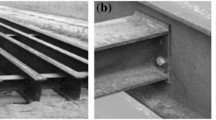Abstract
Predicting fatigue crack growth after its detection during in-service inspection is necessary to prevent a loss of serviceability, such as the oil and/or water tightness of critical compartments. This paper focuses on the most typical fatigue cracks that start at the weld joint between a flat bar stiffener on a transverse web frame and the flange of a longitudinal stiffener on a bottom plate or inner bottom plate. An experiment is carried out to observe the fatigue crack propagation for two kinds of flat bars at the abovementioned connection. The experimental results, especially the surface crack growth on the flange (which dominates during the total fatigue life of the longitudinal stiffener), are compared with crack growth curves predicted using a few existing formulas. Based on the comparative study, a formula that shows the best agreement with the experiment results is selected. Weld toe magnification factors for the web stiffener are computed from the crack propagation rates measured in the experiment, and two equations for the magnification factors versus crack depth are developed for two types of web stiffeners. The selected existing formula and the proposed equations are applied to two connections at the inner bottom and side longitudinal bulkhead of an LNG carrier. The equivalent stress approach based on a long-term distribution is employed to avoid the complexity involved in dealing with the actual stress history. Using this prediction, the remaining service life until an oil or water leakage occurs at a tank boundary can be estimated when a fatigue crack at the connection is detected.





















Similar content being viewed by others
References
Mizukami T, Ishikawa I, Yuasa M (1994) Trends of recent hull damage and countermeasures. Class NK Tech Bull 12:25–45
Okamoto T, Toyosada M (1979) Fatigue crack initiation and propagation at a bracket end weld toe. J Kansai Soc Nav Archit 175:31–41
Kataza T, Murata S, Tateishi M, Toyosada M, Okamoto T, Fujiwara H, Miwa S, Kanazawa T (1981) A proposal of fracture control design procedure. J Soc Nav Archit Jpn 149:174–194
Sumi Y, Chen Y, Hayashi S (1996) Morphological aspects of fatigue crack propagation, part I—computational procedure. Int J Fract 82:205–220
Sumi Y, Chen Y, Wang ZN (1996) Morphological aspects of fatigue crack propagation, part II—effects of stress biaxiality and welding residual stress. Int J Fract 82(3):221–235
Sumi Y (1998) Fatigue crack propagation and computational remaining life assessment of ship structures. J Mar Sci Technol 3(2):102–112
Sumi Y, Mohri M, Kawamura Y (2004) Computational prediction of fatigue crack paths in ship structural details. Fatigue Fract Eng Mater Struct 28(1–2):107–115
Sumi Y, Mohri M (2004) Simulation-based fatigue crack management for ship structural details. In: Proc 9th Symp on Practical Design of Ships and Other Floating Structures, Luebeek-Travemuende, Germany, 12- 17 Sept 2004
Chun YC, Kim YI, Kang JK, Han JM (2001) A study on fatigue life prediction of welded joints through fatigue test and crack propagation analysis. J Soc Nav Archit Korea 38(3):99–106
Det Norske Veritas (2005) Fatigue strength analysis of offshore steel structures (RP-203). Det Norske Veritas, Hovik
Verreman Y, Baïlon JP, Masounave J (1987) Fatigue life prediction of welded joints—a re-assessment. Fatigue Fract Eng Mater Struct 10(1):17–36
Matsuoka K, Fujii E (1995) An evaluation method on fatigue crack initiation life at welded joints in steel structures. J Soc Nav Archit Jpn 178:513–522
Det Norske Veritas (2003) Fatigue assessment of ship structures (Classification Notes, No. 30.7). Det Norske Veritas, Hovik
British Standards Institution (1980) BS 5400: Pt 10: Specification for steel, concrete and composite bridges. In: Code of practice for fatigue. British Standards Institution, London
Newman JC, Raju IS (1981) An empirical stress–intensity factor equation for the surface crack. Eng Fract Mech 15:185–192
Newman JC, Raju IS (1979) Stress-intensity factors for a wide range of semi-elliptical surface cracks in finite-thickness plates. Eng Fract Mech 11:817–829
Maddox SJ (1975) An analysis of fatigue cracks in fillet welded joints. Int J Fract 11:221–243
Wang X, Lambert SB (1998) Weight functions and stress intensity factors for semi-elliptical cracks in T-plate welded joints. Fatigue Fract Eng Mater Struct 21:99–117
Bowness D, Lee MK (1996) Stress intensity factor solutions for semi-elliptical weld toe cracks in T-butt geometries. Fatigue Fract Eng Mater Struct 19(6):787–797
Elber W (1971) The significance of fatigue crack closure, damage tolerance in aircraft structures (ASTM STP 486). American Society for Testing and Materials, Philadelphia, pp 230–242
Lu YL (1995) A practical procedure for evaluating SIFs along fronts of semi-elliptical surface cracks at weld toes in complex stress fields. Int J Fatigue 18(2):127–135
Foroughi R, Radon JC (1988) Crack closure behavior of surface cracks under pure bending. In: Newman JC Jr, Elber W (eds) Mechanics of fatigue crack closure (ASTM STP 982). American Society for Testing and Materials, Philadelphia, pp 260–269
Kang SW, Han SH, Kim WS, Paik YM (2003) Fatigue strength of fillet weldment under out-of-plane bending load. J Soc Nav Archit Korea 40(1):28–35
Kawahara M, Kurihara M (1975) A preliminary study on surface crack growth in a combined tensile and bending fatigue process. J Soc Nav Archit Jpn 137:297–306
American Bureau of Shipping (2006) Guide notes on spectral-based fatigue analysis for floating offshore structures. American Bureau of Shipping, Houston
Author information
Authors and Affiliations
Corresponding author
About this article
Cite this article
Jang, BS., Ito, H., Kim, KS. et al. A study of fatigue crack propagation at a web stiffener on a longitudinal stiffener. J Mar Sci Technol 15, 176–189 (2010). https://doi.org/10.1007/s00773-009-0082-1
Received:
Accepted:
Published:
Issue Date:
DOI: https://doi.org/10.1007/s00773-009-0082-1



